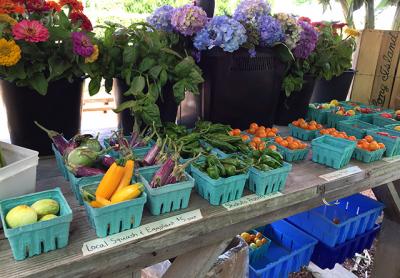Seasons by the Sea: Cook Them While You Can

Although I am eagerly awaiting the arrival of big fat beefsteak tomatoes and sweet white corn at the farm stands, there are plenty of interesting fruits and vegetables available right now. Actually, tomatoes and corn are starting to come in from the North Fork, so have at it. You know what to do with them.
Shishito peppers are everywhere nowadays, and they are tasty morsels that we just didn’t see until about 10 years ago. They are thin, about three to four inches long with puckery skin. I call them the Russian roulette of peppers, because you can munch on a bowlful of them and then suddenly get a super hot one. Usually 1 in 10 is spicy. (They are related to, and often confused with, padron peppers, which are shorter and fatter and tend to be a bit spicier.) Shishitos are also referred to as shishitogarashi in Japan, because the tip of the pepper is thought to resemble a lion’s head, or “shishi.”
The simplest way to prepare them is to fry in a pan with a little bit of oil or blister them on the grill. They take very little time to cook because they are thin-skinned. Some people recommend poking a hole in each before frying, because they can pop and spurt all over the stovetop if you’re not careful. Sprinkle with a little salt and perhaps some lemon juice and you’ve got a quick, healthy appetizer to go with your cocktails.
Japanese eggplant are another fruit (yes, fruit) that is plentiful right now, and they are a lot easier to cook than their elephantine relatives. They have thinner skin, are almost seedless, and are less bitter. These are also simple to cook; throw them on the grill or roast on a sheet pan in the oven. They absorb flavors easily, so just a little bit of miso or soy sauce and garlic or sesame oil are perfect on top.
There are a lot of other small, mild eggplants available right now like Chinese (long and thin like the Japanese), Rosa Bianca, an Italian heirloom variety that is round with purple and white stripes, and many green, white, lavender, and pink eggplant of different shapes and sizes. Some believe the male is less bitter because of fewer seeds, so if you want to sex your eggplant, take a look at the bottom. If the indentation is deep and shaped like a dash, it is female. If it is shallow and round, it is a male.
And now for one of my favorites this time of year: the zucchini blossom. These are used a lot in Italian and Mexican cooking, but you don’t see them often on menus out here. They can be shredded and incorporated into risottos, used as a pizza topping, and stuffed with cheese and spices. I prefer them simply fried, because their flavor is so delicate. In Italy they are the jalapeño popper of the jet set.
First a little botany lesson. The male blossom grows from a stem and has stamens, the thin filaments with anthers at the top. The female blossom has the fruit at the stem and has a pistil at the center of the flower. I prefer the male blossoms. While some say you don’t need to remove the pistils or stamens, I do, as this can add some bitterness to the flavor. The Italians also recommend shaving off a bit of the leaves because these are prickly. You should take a look at what’s available at farmer’s markets and farm stands because the size and price can vary wildly. I saw a sad bunch wilting in the sun a few weeks ago at one vendor’s stand (at $1 per blossom!) and saw another bunch, bigger and healthier and cheaper at another. Once you get them home, open them gently and rinse. There may still be some pollinators inside going about their business. Remove the pistils and/or stamens and lay out on paper towels to dry. Once dry you can proceed with whatever recipe you like, but I strongly suggest you try them simply fried with a bit of garlic and chopped parsley in the batter.
Last but not least is another in-season “what do I do with these” fruit: okra. Having grown up in the South, I am absolutely mad for okra and grits and all those things that Northerners turn their noses up at. When stewed, okra releases its gummy, gluey mucilage, which is useful for thickening gumbos and soups. But if you fry them briefly, either sliced or whole, they retain a crispness similar to green beans. You can also pickle them.
Okra, a member of the mallow family, is very nutritious. If you’ve ever seen an okra flower you would see the resemblance. They are also related to cotton and hibiscus and are of northeast African origin. They are full of vitamins A, K, and C, along with folates, minerals, flavonoid anti-oxidants like beta-carotene, xanthan, and lutein. Okra has also been called “green Viagra,” because the polysaccharides in okra open up the arteries in a similar way, according to the Institute of Food Technologies. When buying or picking okra, you want smallish ones, about three to four inches long, and you should cook them within a few days.
Tomatoes and corn will be here soon enough, along with zucchini the size of an N.B.A. player’s Nike Jordan Melo M12 sneaker. So try these often overlooked but oh, so delicious fruits and vegetables while they’re still available at our farm stands.
Click for recipes
